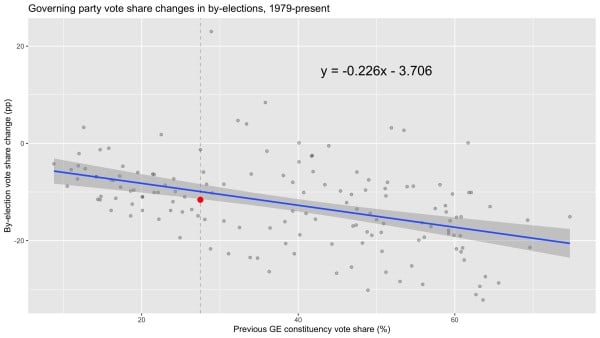
Is Labour on course for government?
Patrick Flynn
10 January 2023
Labour’s lead over the Conservatives in the polls stands at around 20 points. By all accounts, Labour would win by a landslide majority if an election was held today. However, the next election does not have to take place until January 2025 and a lot can change in the space of two years. Based on what we know right now, can we say that Labour is on course for government?
Smarkets prices currently suggest that there is a 73% chance that Labour will win the most votes at the next election and a 49% chance that they will win a majority. While prediction markets are helpful, are there other angles we can look at?
The government’s performance in by-elections may be a useful metric. After all, these are hard election results, rather than hypothetical ones.
Social media was awash with debate in December about how to interpret the results of the Stretford and Urmston by-election. Some argued that the 10.5-point swing from the Conservatives to Labour would not be enough to give Labour a majority in a general election, while others pointed out that Stretford and Urmston is a safe Labour seat, so the swing would always be limited as they have fewer voters available to convert. I think there is merit in both positions.
First of all, there is an element of proportionality to by-election swings. One would expect less movement to Labour in seats like Stretford and Urmston where the Conservative vote share was relatively weak at the last election. On this point, the latter group is correct — a Conservative drop of 11.6 points would likely be higher in a marginal seat.
However, the former group’s caution is also sensible. The drop in the Conservative vote share in S&U was roughly what one would expect for a governing party based on their previous constituency result, so there was no evidence pointing to a national wipeout from this particular by-election.

While it’s correct to say that a 10.5-point swing in a general election would see the Conservatives lose over 100 seats, by-elections are not general elections - and they tend to be much more punitive for the government than the national polls would indicate.
On the whole, however, by-elections are a pretty good indicator of future government performance. Between 1992 and 1997, the Tory vote share fell by an average of 20 percentage points in by-elections before they were voted out of office on a double-digit swing. On the other hand, though Labour’s vote share fell by the same amount between 2001 and 2005, they still held onto power at the 2005 election despite a 5.5-point reduction in their vote share.
Given the scale of the swing needed for Labour to form a majority at the next election, they would need some pretty hefty vote increases in by-elections to be confident of future success. Based on historic patterns, the three most recent by-elections (where Labour have performed pretty well) only point towards a hung parliament.
Still, I’m of the belief that national polls are a better predictor than by-elections in localised areas. Labour’s lead in the polls right now is enormous, but, historically speaking, that seems unlikely to hold.
I’m currently working on a more detailed model for forecasting election vote shares based on midterm polling, but a 20-point lead for the opposition at this stage in the parliament - generally the weakest point for the government - points towards an election-day lead in the low single figures, with a roughly three-in-four chance that the opposition will win the most votes. Interestingly, this lines up pretty well with the prediction markets, which put Labour at 73%.
When it comes to the likelihood of a Labour majority, I think the markets are overly confident. Given Labour’s position in Scotland, the party will probably need a lead of at least eight points nationally to obtain a majority. Based purely on the aforementioned midterm model, a hung parliament again seems the most likely outcome.
However, there is some evidence that Labour’s lead may be harder than some previous oppositions and there is no escaping the government’s poor ratings on economic competence, among other things.
Given the economic situation and some positive underlying numbers for Labour, there’s certainly a strong argument to be made that the swing to the government may be smaller between now and the next election than history suggests. With that said, I’m backing a hung parliament right now rather than a Labour majority.
Patrick Flynn
10 January 2023


